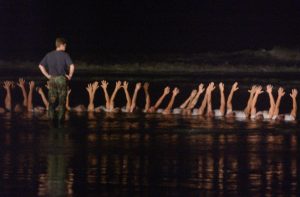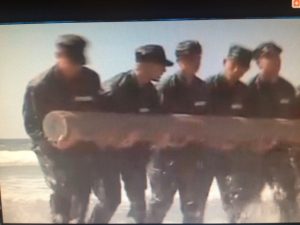Navy SEAL BUD/S training is one of the most demanding military training programs in the world. It is the initial and most famous step for anyone wanting to join the elite ranks of the Navy SEALs. Many ask what exactly BUD/S involves and how long is the journey through this formidable course.
This training pushes individuals far beyond their perceived physical and mental limits. It forges the world’s premier maritime special operations force. Here, we will break down the entire process from start to finish.
Table of Contents:
- What is Navy SEAL BUD/S Training?
- How Long is Navy SEAL BUD/S Training?
- What Happens After BUD/S?
- The Requirements to Attend BUD/S
- The Physical Demands of BUD/S Training
- The Mental Challenge of BUD/S
- Why is BUD/S Training So Intense?
- The Success Rate of BUD/S Training
- Preparing for BUD/S Training
- The Legacy of BUD/S Training
- Conclusion
What is Navy SEAL BUD/S Training?
BUD/S stands for Basic Underwater Demolition/SEAL training. It is the foundational training program that all prospective Navy SEALs, both officer and enlisted, must successfully complete. This intense six-month course is located at the Naval Special Warfare Center in Coronado, California.
The program’s primary function is to identify and select candidates who possess the character, physical strength, and mental fortitude required for special warfare. The origins of this training can be traced back to the Frogmen of World War II, who formed the Underwater Demolition Teams. The modern BUD/S training program was established to create a new kind of warrior capable of operating across sea, air, and land.
Every aspect of the BUD/S Navy SEAL training is constructed to test a candidate’s will to succeed. The instructors, all seasoned SEALs themselves, create a high-stress environment to see who has the dedication to join a SEAL team. It is a true test of grit and determination.

How Long is Navy SEAL BUD/S Training?
The core of BUD/S training lasts for 24 weeks, or about six months. This period is broken down into three distinct phases, each with a specific focus. However, this is just one part of the long path to earning the coveted Navy SEAL Trident.
Before even starting, candidates go through an initial preparatory school to get them ready for the physical demands. After graduating BUD/S, they continue to SEAL Qualification Training (SQT) and other advanced courses. The full pipeline from walking into a recruiter’s office to joining a SEAL team can take over two years.
| Stage | Duration | Primary Focus |
|---|---|---|
| Pre-BUD/S (Naval Special Warfare Preparatory School) | 8 Weeks | Physical Screening Test (PST) preparation and improvement. |
| BUD/S Phase 1: Basic Conditioning | 7 Weeks | Physical conditioning, teamwork, and mental toughness. Includes Hell Week. |
| BUD/S Phase 2: Combat Diving | 7 Weeks | Underwater skills, combat swimming, and scuba diving. |
| BUD/S Phase 3: Land Warfare | 7 Weeks | Weapons training, demolitions, and small unit tactics. |
| Post-BUD/S (Parachute Training) | 3 Weeks | Static-line and freefall parachute jumping. |
| SEAL Qualification Training (SQT) | 26 Weeks | Advanced skills, SERE, and earning the Navy SEAL Trident. |
First Phase: Basic Conditioning
The first phase of BUD/S training, also known as the physical conditioning phase, lasts seven weeks and is dedicated to building a foundation of strength, endurance, and teamwork. Seal candidates are pushed with relentless physical training, including running in the soft sand, swimming in the cold Pacific, and countless repetitions of calisthenics. This phase â focuses on making the class work as a single unit.
A typical day involves long runs, swims, and completing a timed obstacle course. Much of the physical activity is team-based, like carrying heavy logs and inflatable boats, which teaches the importance of working together. This part of the training program systematically breaks down individuals and rebuilds them as cohesive team members.
The centerpiece of this phase is the infamous Hell Week. It is a five-and-a-half-hour crucible where candidates are subjected to continuous training with a total sleep time of only about four hours. This test of endurance, pain tolerance, and teamwork is where the majority of dropouts occur.
Second Phase: Combat Diving
After completing basic conditioning, the BUD/S class moves to the second phase, which focuses on combat diving. This seven-week phase introduces candidates to the underwater skills that are fundamental to Navy SEAL operations. This part of the training is where the “U” and “D” in BUD/S (underwater demolition) truly come into play.
Trainees learn the fundamentals of basic underwater navigation and operations. They become proficient with both open-circuit SCUBA and scuba closed-circuit rebreathers, which do not produce bubbles and are vital for stealth. The combat swimming portion teaches them to be efficient and comfortable in the water under any conditions.
As it requires candidates to pass rigorous tests, this phase is extremely challenging, requiring candidates to pass difficult water competency tests. They must demonstrate proficiency in solving problems underwater while under stress, and weed out those who are not completely at home in the aquatic environment.
Third Phase: Land Warfare
The final seven-week phase of SEAL BUD/S training is land warfare. This Phase 3 land warfare portion takes place on San Clemente Island, a rugged and remote location off the coast of California. Here, the focus shifts to basic weapons, demolitions, and small-unit tactics.
Candidates receive comprehensive weapons training on pistols, rifles, and crew-served weapons. They learn to handle explosives, conduct ambushes, and execute small-unit patrols. This land warfare training is critical for preparing them for the diverse missions they will face.
The training culminates in exercises that combine all the skills they have learned. By the end of this phase, the remaining candidates will have demonstrated basic competency in maritime, diving, and small-unit land operations. They are then ready to graduate from basic underwater demolition and SEAL training.
What Happens After BUD/S?
Graduating from BUD/S or Navy SEAL training is a monumental step, but the journey is far from over. After receiving their diploma, the graduates are not yet Navy SEALs. They must complete further qualification training to earn their place in the community.
The first stop after BUD/S is Basic Parachute Training at Fort Benning, Georgia. Following that, they attend the 26-week SEAL Qualification Training (SQT). SQT offers advanced instruction in core mission areas, including unconventional warfare, close-quarters combat, and survival training.
It is only after successfully completing SQT that a trainee is awarded the Navy SEAL Trident and officially becomes a Navy SEAL. From there, they are assigned to a SEAL Team and begin 12-18 months of unit-level training before their first deployment. This continuous training ensures they are always at peak readiness.
The Requirements to Attend BUD/S
There are strict requirements even to get a chance to attend bud/s. Both officer and enlisted candidates must meet high standards. The seal officer requirements and seal enlisted requirements are similar in many ways, but the selection process for officers is exceptionally competitive.
Enlisted candidates must be US citizens, between 18 and 28 years old, and have a high school diploma. They need to achieve qualifying scores on the ASVAB test and pass a stringent physical screening test (PST). Specific enlisted requirements also include passing a dive physical and having correctable vision.
The officer requirements mandate a four-year college degree and successful completion of Officer Candidate School or graduation from the Naval Academy. Like their enlisted counterparts, they must pass the PST and meet all physical and citizenship criteria. The path for a SEAL officer involves leading teams in complex operations.
The Physical Demands of BUD/S Training
The physical toll of BUD/S is immense and well-documented. Candidates are engaged in constant physical training, often with little rest. The brute force philosophy is about more than just building muscle; it is about forging resilience.
Activities include running for miles in combat boots on soft sand, taking long ocean swims in cold water, and engaging in relentless calisthenics. They must repeatedly conquer a timed obstacle course. Trainees also endure Log PT, where teams of six carry a 200-pound log for miles and workouts with force sandbags.
Aspiring candidates should consult the official NSW PT Guide to prepare. The guide provides a structured workout plan focused on the core activities of BUD/S, like the four-mile timed run. Following the NSW PT plan is a solid first step for any SEAL candidate.
The Mental Challenge of BUD/S
While the physical challenges are staggering, many graduates say the mental aspect of SEAL training is the true test. Instructors create an environment of constant stress, cold, and exhaustion. This is meant to reveal a candidate’s underlying character and mental toughness.
Candidates must learn to control their emotions, suppress their fear, and perform complex tasks while sleep-deprived and physically drained. They are taught the SEAL Ethos, a creed that guides every member of the Naval Special Warfare community. The ethos emphasizes teamwork, humility, and a commitment to never quitting.
The mental games are just as important as the physical evolutions. Instructors want to see who can remain calm, think clearly, and lead others when everything is going wrong. This psychological pressure is what forges a warrior capable of operating in the most hostile environments on earth.
Why is BUD/S Training So Intense?
The extreme intensity of Navy SEAL training directly relates to the nature of special warfare missions. SEALs operate in small teams, often deep behind enemy lines with limited support. The consequences of failure are severe, so only the most capable individuals can be selected.
The shared hardship builds unbreakable bonds between teammates, a trust that is vital in combat. It strips away ego and forces candidates to rely on each other to survive. This experience ensures that every graduate understands the importance of the team over the individual.
The training simulates the chaos and stress of real combat as closely as possible. It is constructed to instill the “never quit” mindset that defines the SEAL teams. When a Navy SEAL faces a difficult situation on a mission, they can draw on their experience from BUD/S.
The Success Rate of BUD/S Training
The attrition rate at BUD/S is exceptionally high, which is a testament to its difficulty. Historically, only about 20-25% of candidates who start the program will finish it. Most who leave do so voluntarily by “ringing the bell,” a brass bell that trainees can ring three times to signal their intention to quit.
The majority of attrition occurs in the first phase, particularly during “hell week.” Those who make it through the initial weeks have a much higher chance of graduating. Earning the right to wear the Navy SEAL trident is a distinction held by a very small percentage of those who try.
Preparing for BUD/S Training
Proper preparation is essential for any candidate seeking to succeed in Basic Underwater Demolition SEAL (BUD/S) training. This preparation starts months, if not years, before shipping off to Coronado. A solid plan is required to build the necessary physical and mental foundation.
An Aspiring candidate should focus their physical training on running, swimming, and bodyweight strength exercises, as outlined in the PT guide. Becoming extremely comfortable and competent in the water is non-negotiable. Many successful candidates were competitive swimmers or water polo players before joining the Navy.
Mental preparation involves setting long-term goals and developing discipline. Learning about SEAL history and the accomplishments of notable and famous SEALs can provide motivation. It is also important to understand the broader NSW overview, including the role of the Navy SWCC, such as those who operate the boats that support SEAL missions across various duty stations.

The Legacy of BUD/S Training
The BUD/S training program has evolved since its formal inception in the early 1960s, adapting to new threats and technologies. However, its core purpose remains unchanged: to produce mentally tough and physically dominant warriors for the naval special warfare community. This training creates operators who can think on their feet and adapt to any situation.
Graduates of BUD/S have served with distinction in every major conflict since Vietnam. The program is the bedrock of the SEALs’ reputation as one of the world’s most elite fighting forces. It is a legacy built on the sweat and determination of every BUD/S Navy candidate who refused to quit.
The process of seal qualification continues long after graduation. A SEAL is always a student, honing their craft through continuous training with their team. This commitment to excellence is born in the sands of Coronado.
Conclusion
The journey through Navy SEAL BUD/S training is a marathon of pain, exhaustion, and self-discovery. The 24-week course serves as the gateway to the world of Naval Special Warfare, designed to identify the small number of individuals who can operate at the highest level of expertise. From the physical punishment of the First Phase to the tactical challenges of the Second and Third Phases of land warfare & diving physics, every moment is a test.
The total time required to become a fully qualified Navy SEAL is approximately two years, a long and demanding road that demands complete dedication. After BUD/S, trainees proceed to SEAL Qualification Training (SQT) and then join their operational SEAL teams. While BUD/S is the most well-known part of the process, it is only the first of many hurdles.
Those who persevere through the entire Navy SEAL BUD/S pipeline earn more than the Trident. They become part of a brotherhood forged in adversity, ready to execute the nation’s most critical missions. The training is brutal, but it creates the warriors that America needs.
